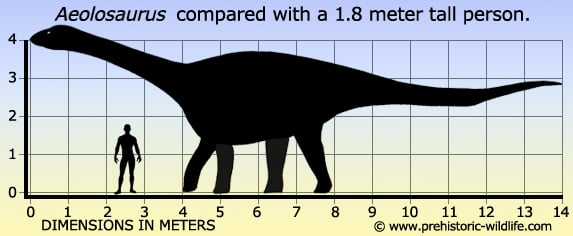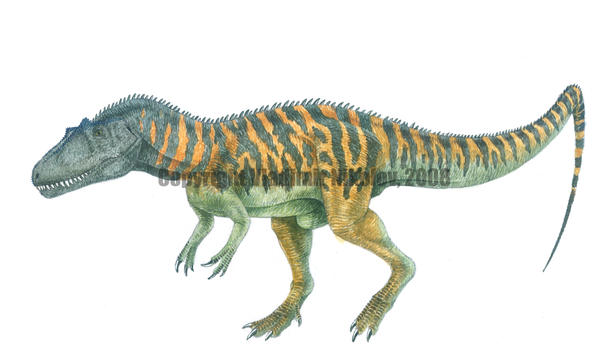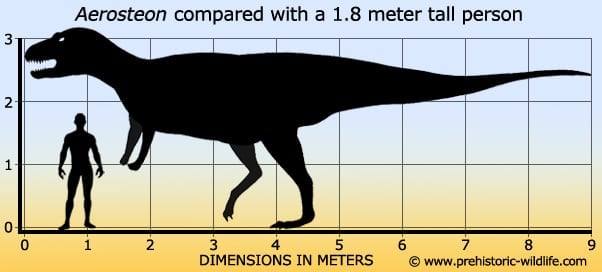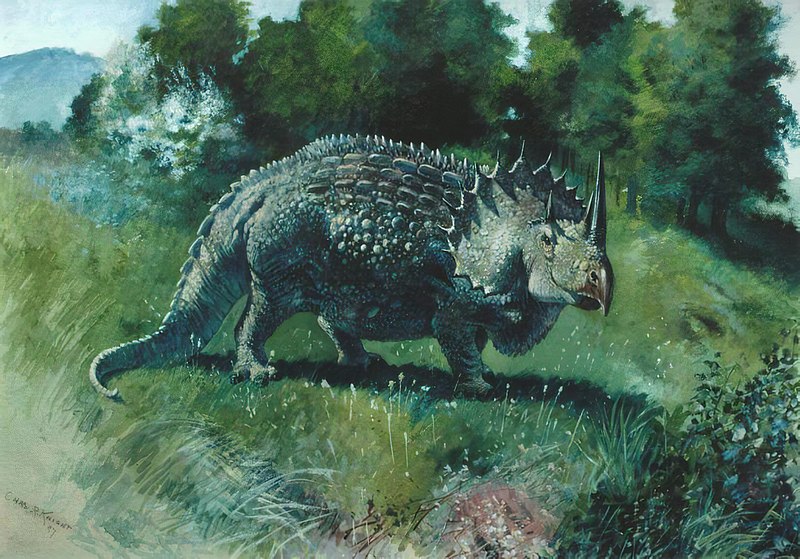[Recent Entries][Archive][Friends][User Info]
February 18th, 2015
| February 18th, 2015 | |
|---|---|
| 04:02 pm [industrialterro] [Link] |
Aeolosaurus Эолозавр (Aeolosaurus) — род травоядных динозавров из группы титанозавров инфраотряда зауроподов, живший в меловом периоде около 70—68 миллионов лет назад, на территории нынешней Южной Америки. Окаменелости четвероногого зауропода были найдены в Аргентине и Бразилии. Описаны Powell в 1987 году. Всего известно 3 вида эолозавров: Aeolosaurus colhuehuapensis. Aeolosaurus maximus — вид, описанный в 2011 году. Находка была сделана в формации Adamantina на территории современной Бразилии. Aeolosaurus rionegrinus. Aeolosaurus (/ˌiː.əlɵˈsɔrəs/; "Aeolus' lizard") is a genus of titanosaurian sauropod dinosaur from the Late Cretaceous Period of what is now South America. Like most sauropods, it would have been a quadrupedal herbivore with a long neck and tail. The remains of this dinosaur are incomplete, so size can only be estimated but Aeolosaurus was probably at least 45 feet (14 m) in length. This dinosaur is named after the Greek mythological figure Aeolus, Keeper of the Winds in Homer's Odyssey, because of the frequent winds that blow across Patagonia, where the remains were found. The generic name also includes the Greek sauros ('lizard'), the traditional suffix used in dinosaur names. The specific name (A. rionegrinus), refers to its location, in the Rio Negro Province of Argentina. Both genus and species were named and described by Argentine paleontologist Jaime Powell in 1987. The holotype of Aeolosaurus rionegrinus consists of a series of seven tail vertebrae, as well as parts of both forelimbs and the right hindlimb. It was discovered in the Angostura Colorada Formation in Argentina, which dates from the Campanian stage of the Late Cretaceous, about 83 to 74 million years ago. Relationships among the many titanosaurian sauropods are hazy at best, but Aeolosaurus has been tentatively linked to a few other genera, based on features of the tail vertebrae, including Rinconsaurus and Adamantisaurus. Gondwanatitan and Aeolosaurus both exhibit neural spines on the tail vertebrae that point forwards, a feature not seen in any other known titanosaurians. The vertebrae from the middle part of its tail had elongated centra. Aeolosaurus had vertebral lateral fossae that resembled shallow depressions. Fossae that similarly resemble shallow depressions are known from Saltasaurus, Alamosaurus, Malawisaurus, and Gondwanatitan. Venenosaurus also had depression-like fossae, but its "depressions" penetrated deeper into the vertebrae, were divided into two chambers, and extend farther into the vertebral columns. Its middle tail vertebrae's neural spines angled anteriorly when the vertebrae are aligned. These vertebrae resemble those of Cedarosaurus, Venenosaurus, and Gondwanatitan. Another specimen, described in 1993, consists of five tail vertebrae, and some bones from the forelimb and pelvis. Since there are two right ulna (forearm) bones, the specimen must consist of at least two individuals. These bones were also associated with two osteoderms, or bony armor plates, providing evidence that this dinosaur was armored. This specimen is from the Allen Formation of Rio Negro, dating back about 70 to 68 million years ago to the middle Maastrichtian stage. While this specimen bears features that characterize the genus Aeolosaurus, it is from a younger time period and shows enough differences that the authors recognized it as a possible second species. Another partial skeleton, including four more tail vertebrae and material from both limbs on the left side of the body, was described in 1997. This was recovered from the Los Alamitos Formation of Rio Negro, which falls between the other two dates. This specimen was also referred to the genus Aeolosaurus, but not to the species A. rionegrinus, and may represent a third species. However, since the genus Aeolosaurus is not well known, the authors chose not to formally name either of these possible new species. For now, they are both simply known as "Aeolosaurus sp." Future discoveries may give scientists more information on variation within the genus, and show that all of the above specimens belong to A. rionegrinus, or that they merit being formally named. Another series of 15 tail vertebrae was assigned to Aeolosaurus in the original description, but it was later determined that the series does not belong to this genus, as it lacks several features found in the other specimens of Aeolosaurus. Размеры тела в сравнении с человеком: Tags: Вымершие рептилии, Мел, авеметатарзалии, архозавроморфы, архозавры, диапсиды, динозавроморфы, динозавры, завроподоморфы, завроподы, макронары, титанозавроформы, титанозавры, ящеротазовые |
| Time | Event |
| 04:39 pm [industrialterro] [Link] |
Aerosteon Аэростеон (Aerosteon, от др.-греч. ἀερο- + ὀστέον «воздушная кость») — род ящеротазовых динозавров из семейства Neovenatoridae, подотряда тероподов, живший в меловом периоде около 85 — 74 миллионов лет назад, на территории нынешней Южной Америки. Окаменелости теропода были найдены в Аргентине. Описаны Полом Серено в 2008 году. Всего известен один скелет Aerosteon. Представлен единственным видом — A. riocoloradensis. В результате анализа дыхательной системы этого ящера было найдено сходство с современными птицами. Этот анализ окаменелостей показывает эволюционные связи между динозаврами и современными птицами. Aerosteon is a genus of either allosauroid or tyrannosauroid theropod dinosaur from the Late Cretaceous period of Argentina. Its remains were discovered in 1996 in the Anacleto Formation, dating to the Santonian stage (about 84 million years ago). The type and only known species is A. riocoloradense. Its specific name indicates that its remains were found 1 km north of the Río Colorado, in the province of Mendoza. They show evidence of a bird-like respiratory system. Aerosteon's name can be translated as air bone and derives from Greek ἀήρ (aer, "air") and ὀστέον (osteon, "bone"). Though the species name was originally published as "riocoloradensis", Greek ὀστέον is neuter gender, so according to the ICZN the species name must be riocoloradense to match. Aerosteon was a 9 metre (30 ft) long, 2 metric ton bipedal carnivorous dinosaur that lived approximately 83 million years ago during the Santonian stage. The remains discovered include a single tooth, some cranial bones, a number of partial or complete vertebrae from the neck, back, and sacrum, several cervical and dorsal ribs, gastralia, furcula (wishbone), left scapulocoracoid, left ilium, and left and right pubes. The incomplete fusion of some of its bones indicate that it was not quite fully mature. Aerosteon did not initially appear to belong to any of the three groups of large theropods that were known to have inhabited the southern continents during this time (namely the Abelisauridae, Carcharodontosauridae or Spinosauridae). Sereno suggested that it might be related to the allosauroid radiation of the Jurassic period, and this was confirmed in subsequent studies that recognized a clade of late-surviving, lightly built, advanced allosauroids with large hand claws similar to the spinosaurs, called the Megaraptora, within the allosaur family Neovenatoridae. A later analysis has placed Aerosteon within the Tyrannosauroidea. Some of Aerosteon's bones show pneumatisation (air-filled spaces), including pneumatic hollowing of the furcula and ilium, and pneumatisation of several gastralia, suggesting that it may have had a respiratory air-sac system similar to that of modern birds. These air sacs would have acted like bellows, moving air into and out of the animal's relatively inflexible lungs, instead of the lungs being expanded and contracted as occurs with mammals. See avian respiratory system for more detailed information on this. Sereno theorises that this respiratory system may have developed to assist with regulating body temperature and was later co-opted for breathing. Aerosteon was first described by Sereno et al. in a paper which appeared in the online journal PLoS ONE in September 2008. However, at the time, the International Code of Zoological Nomenclature did not recognize online publication of names for new species as valid unless print copies were also produced and distributed to several libraries, and that this action is noted in the paper itself. PLoS ONE initially failed to meet this requirement for Aerosteon. On 21 May 2009, the journal's managing editor coordinated with the ICZN to correct this oversight, publishing a comment to the original paper with an addendum stating that the requirements had been met as of that date. Consequently, though the description appeared in 2008, Aerosteon was not a valid name until 2009. Неовенаториды (Neovenatoridae) — семейство больших плотоядных динозавров, из надотряда Allosauroidea, живших в меловом периоде около 130—70 миллионов лет назад. Неовенаториды являются последними представителями аллозавроидов, по крайней мере один из их представителей — Orkoraptor жил в конце мелового периода (маастрихт), примерно 70 миллионов лет назад. Лопатки более короткие и широкие, маленькие, длинные передние конечности с большими когтями, приспособленные к быстрому бегу ноги и тазовые кости, которые для пневматизации имели заполненные воздухом полости и были легче по сравнению с другими Allosauroidea. Взрослые особи достигали размера от 175 кг (фукуираптор) до примерно 2500 кг (хилантаизавр). В 2009 году кладистический анализ проведенный Роджером Бенсоном и его коллегами, показал, что группа Carcharodontosauridae требует пересмотра, и необходимо было разделить ее на две ветви. Одна ветвь включала более традиционные виды, которые считались Carcharodontosauridae и сохранила свое название, другая ветвь состояла из Neovenator и некоторых родственных видов и была названа в 2010 году Neovenatoridae. Семейство Neovenatoridae было определено как: группа, состоящая из всех видов более тесно связаных с Neovenator salerii, чем Carcharodontosaurus saharicus, Allosaurus fragilis и Sinraptor dongi. ( Read More ) Размеры тела в сравнении с человеком: Tags: Вымершие рептилии, Мел, авеметатарзалии, архозавроморфы, архозавры, диапсиды, динозавроморфы, динозавры, карнозавры, неовенаториды, тероподы, ящеротазовые |
| Time | Event |
| 06:23 pm [industrialterro] [Link] |
Agathaumas Агатаум (от Agataumas — «огромное изумление») — сомнительный род динозавров семейства Цератопсиды, живших 70—65 млн лет назад (середина кампанского — конец маастрихского яруса позднего мелового периода) на территории нынешней Северной Америки. Достигал в длину 9 метров, высоты 3 метра и веса 5 тонн. Окаменелости агатаума были найдены в округе Суитуотер (Sweetwater County) штата Вайоминг. Впервые описан палеонтологом Коупом в 1874 году. Представлен одним видом — Agathaumas sylvestris. Останки агатаума обнаружил американский учёный Ф. Меек в 1873 году при раскопках в штате Вайоминг (США). Он сообщил об этом известному палеонтологу Эдварду Коупу, который немедленно прибыл на место и занялся изучением находки. Название своё — «огромное изумление» — агатаум получил потому, что учёные были сильно потрясены размерами животного. В 1897 году художник Чарльз Найт по заказу Э. Коупа сделал ряд рисунков ящера, которые в 1925 году послужили Уиллису О’Брайну основой для создания образа агатаума в фильме «Затерянный мир». Agathaumas (/æɡəˈθɔːməs/; "great wonder") is a dubious genus of a large ceratopsid dinosaur that lived in Wyoming during the Late Cretaceous (late Maastrichtian stage, 66 million years ago). The name comes from Greek, αγαν - 'much' and θαυμα - 'wonder'. It is estimated to have been 9 metres (30 ft) long and weighed 6 tonnes (5.9 long tons; 6.6 short tons), and was the largest land animal known at the time of its discovery. It was the first ceratopsian known to science, though relatively little is known about it. The original specimen consisted only of the animal's hip bones, hip vertebrae and ribs, and because these bones vary little between ceratopsid species, it is usually considered a nomen dubium. It is provisionally considered a synonym of Triceratops, but is difficult to compare to that genus because it is only known from post-cranial remains. The fossil remains of Agathaumas were first found in 1872 in southwestern Wyoming. They were discovered by Fielding Bradford Meek and H.M. Bannister while they were looking for fossil shells in the Lance Formation (then Laramie Formation) near the Black Butte and Bitter Creek. Meek and Bannister were employed by Ferdinand Hayden's Geological Survey of the Territories, and notified paleontologist Edward Drinker Cope of the find. Cope himself searched the ridge near Black Butte and re-discovered Meek's site, finding huge bones protruding from the rocks near a coal vein. The bones were preserved in sand and clay sediments, packed with fossil sticks and leaves, indicating a heavily forested habitat. Cope later (in 1873) described the skeleton as "the wreck of one of the princes among giants." Later in 1872, Cope published a description and name for the animal, Agathaumas sylvestris, or "marvelous forest-dweller," in reference to its great size and the environment revealed in the same rocks as its bones. The name Agathaumas has been cited as an example of Cope's excitement with this discovery, which was, at the time, the largest known land animal that had ever lived (until several years later, with the discovery of the giant sauropod dinosaurs of the Morrison Formation. Cope and his team eventually recovered complete hip bones, sacral vertebrae, and several ribs from the animal. Since these were the first ceratopsian remains found, Cope was uncertain as to precisely what sort of dinosaur Agathaumas was (and for a time considered it a hadrosaur) until O. C. Marsh described Triceratops in 1889. In an 1889 paper, Cope suggested that Marsh's Ceratopsidae be renamed Agathaumidae, because of the paucity of Ceratops remains. Unfortunately, the bones of the rear half of the animal found are not particularly diagnostic in ceratopsians and Agathaumas remains a nomen dubium. No other remains have been found in the area, but based on its size and age of the rocks, it probably was a Triceratops. Хасмозаврины или цератопсины (Chasmosaurinae или Ceratopsinae) — подсемейство птицетазовых динозавров, обитавших в позднем меловом периоде (около 77—65 миллионов лет назад). Все известные виды были четвероногими и обитали в основном в Северной Америке хотя один вид, Тураноцератопс, известен из отложений Азии. Большинство представителей этого подсемейства обладают лишь шишковатыми «зачаточными» рожками, расположенными над глазницами, в отличие от своих ранних предков), тогда как трицератопс наоборот имеет крупные костяные наросты. Самым ранним из всех известных рогатых динозавров в Северной Америке является зуницератопс (Zuniceratops), живший 90 млн лет назад.
Tags: Вымершие рептилии, Мел, авеметатарзалии, архозавроморфы, архозавры, диапсиды, динозавроморфы, динозавры, маргиноцефалии, неорнитискии, птицетазовые, хасмозаврины, цераподы, цератопсиды, цератопсы |
| Previous Day | 2015/02/18 [Archive] |
Next Day |














